Analysis of John Lewis Partnership Business Environment Report
VerifiedAdded on 2021/02/22
|10
|2789
|123
Report
AI Summary
This report provides a comprehensive analysis of the business environment, focusing on the John Lewis Partnership. It begins by defining and differentiating between various organizational types, including public, private, and voluntary companies, and explores their respective purposes and legal structures. The report then examines the size and scope of these different organizations, using examples like the BBC and Highways England for public companies, John Lewis Partnership and Arcadia Group for private companies, and the Welcome Trust and Red Cross for voluntary companies. It further delves into the interrelationship between various organizational functions within the John Lewis Partnership, such as marketing, production, finance, and human resources, and how these functions contribute to the company's overall objectives. The report also conducts a SWOT analysis to assess the internal strengths and weaknesses of John Lewis, as well as the external opportunities and threats it faces. Finally, it explores the positive and negative impacts of the macro environment on the business, highlighting the relationship between internal conditions and external factors, such as technological advancements and cybercrime, and their implications for the firm's sustainability and consumer trust.
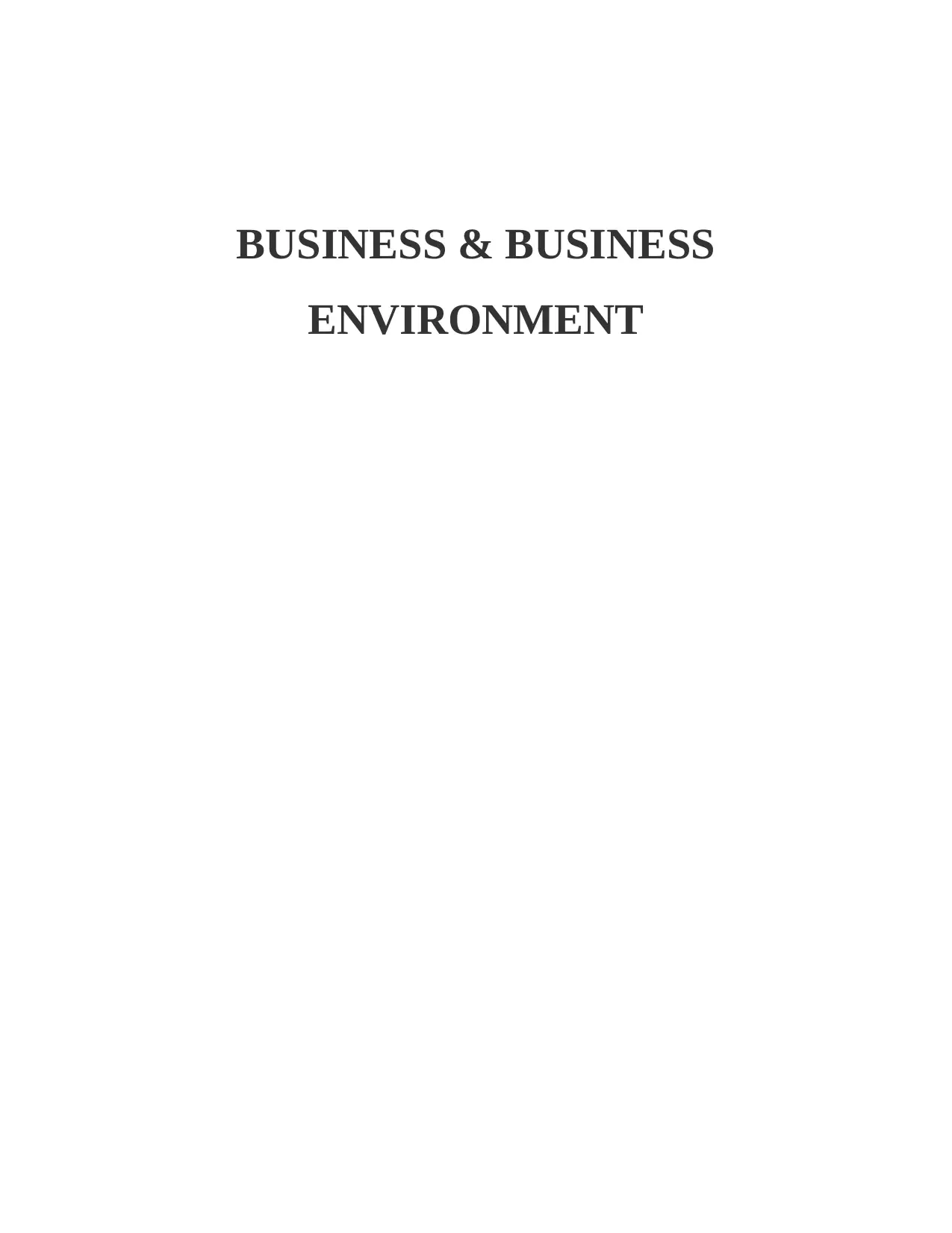
BUSINESS & BUSINESS
ENVIRONMENT
ENVIRONMENT
Paraphrase This Document
Need a fresh take? Get an instant paraphrase of this document with our AI Paraphraser
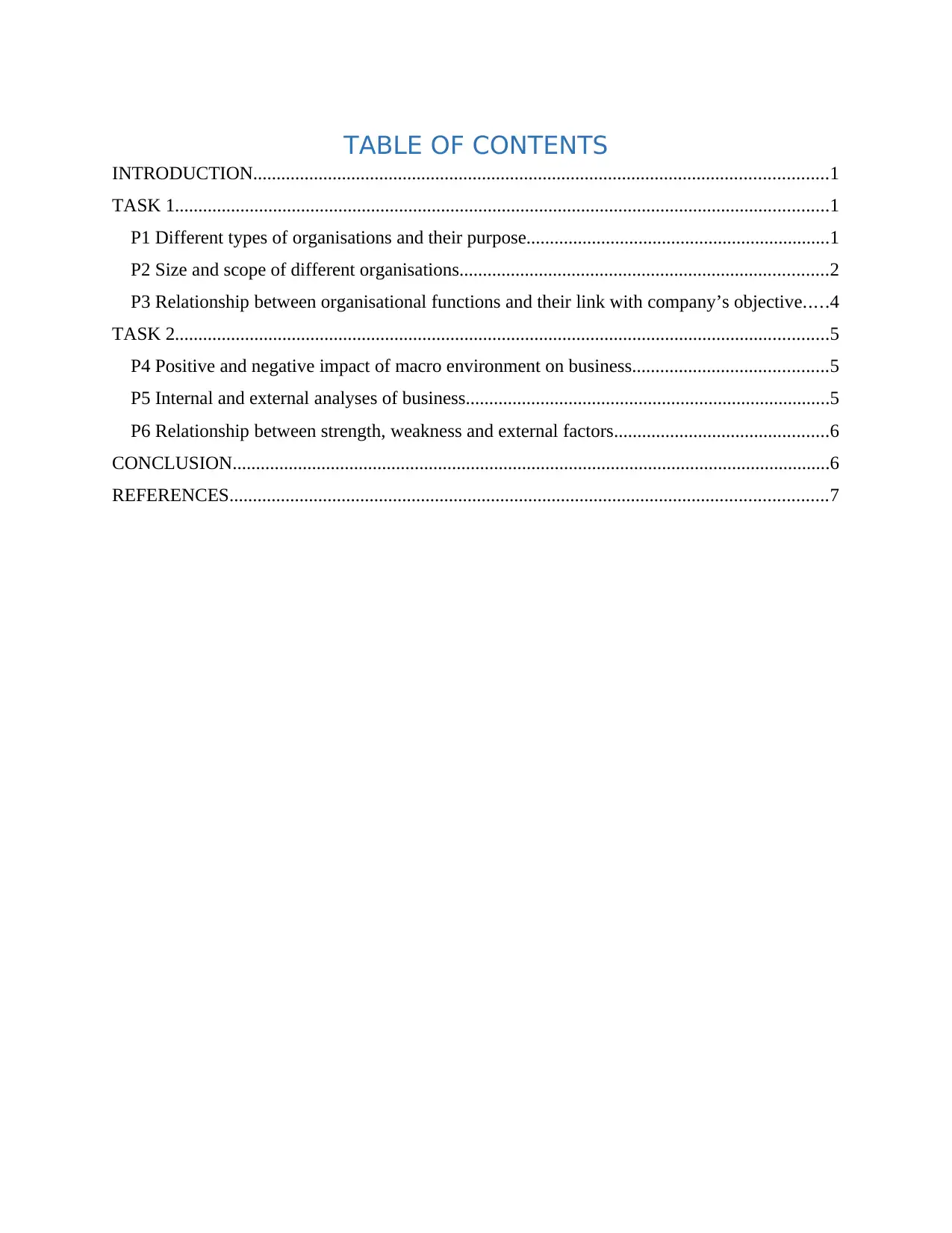
TABLE OF CONTENTS
INTRODUCTION...........................................................................................................................1
TASK 1............................................................................................................................................1
P1 Different types of organisations and their purpose.................................................................1
P2 Size and scope of different organisations...............................................................................2
P3 Relationship between organisational functions and their link with company’s objective.....4
TASK 2............................................................................................................................................5
P4 Positive and negative impact of macro environment on business..........................................5
P5 Internal and external analyses of business..............................................................................5
P6 Relationship between strength, weakness and external factors..............................................6
CONCLUSION................................................................................................................................6
REFERENCES................................................................................................................................7
INTRODUCTION...........................................................................................................................1
TASK 1............................................................................................................................................1
P1 Different types of organisations and their purpose.................................................................1
P2 Size and scope of different organisations...............................................................................2
P3 Relationship between organisational functions and their link with company’s objective.....4
TASK 2............................................................................................................................................5
P4 Positive and negative impact of macro environment on business..........................................5
P5 Internal and external analyses of business..............................................................................5
P6 Relationship between strength, weakness and external factors..............................................6
CONCLUSION................................................................................................................................6
REFERENCES................................................................................................................................7
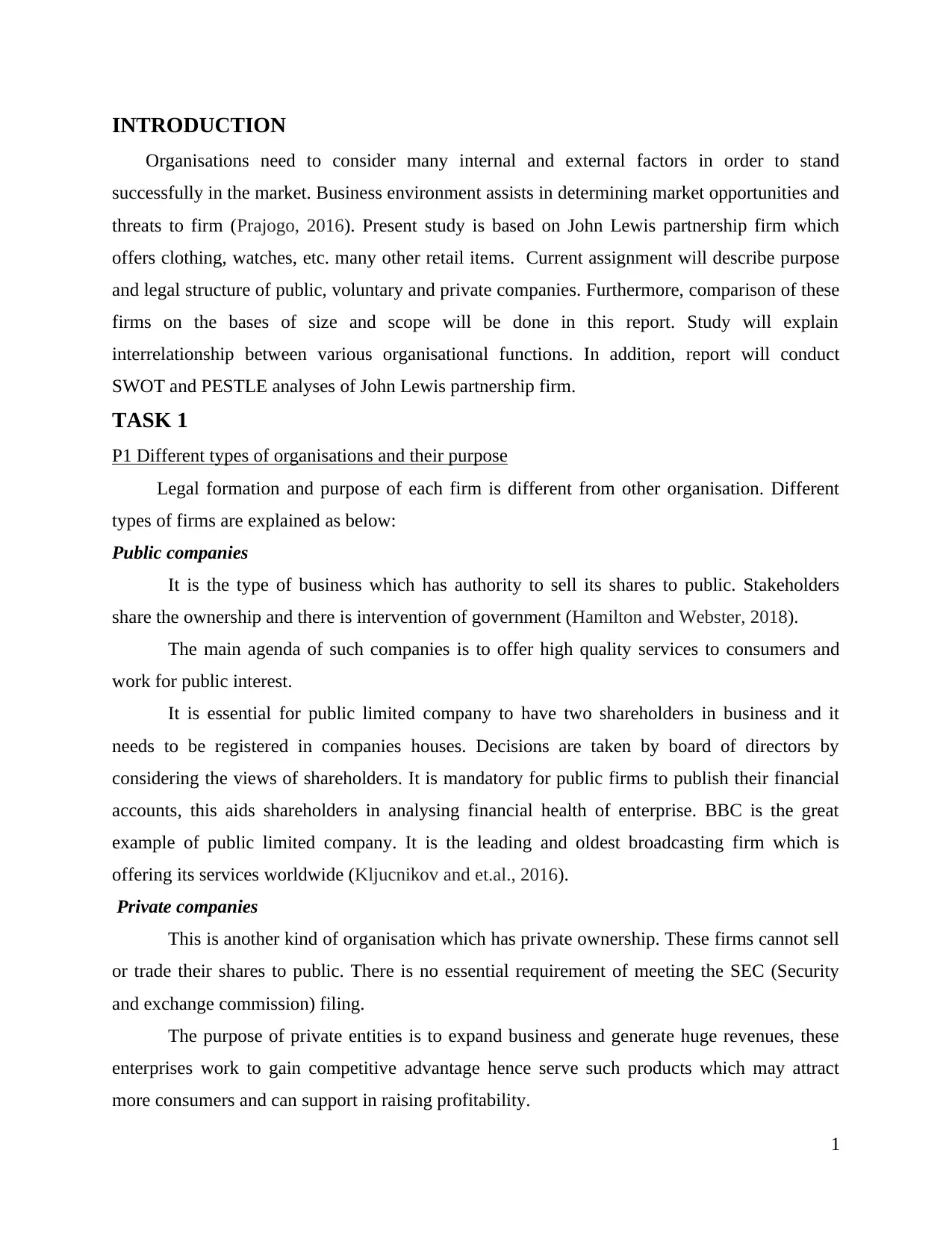
INTRODUCTION
Organisations need to consider many internal and external factors in order to stand
successfully in the market. Business environment assists in determining market opportunities and
threats to firm (Prajogo, 2016). Present study is based on John Lewis partnership firm which
offers clothing, watches, etc. many other retail items. Current assignment will describe purpose
and legal structure of public, voluntary and private companies. Furthermore, comparison of these
firms on the bases of size and scope will be done in this report. Study will explain
interrelationship between various organisational functions. In addition, report will conduct
SWOT and PESTLE analyses of John Lewis partnership firm.
TASK 1
P1 Different types of organisations and their purpose
Legal formation and purpose of each firm is different from other organisation. Different
types of firms are explained as below:
Public companies
It is the type of business which has authority to sell its shares to public. Stakeholders
share the ownership and there is intervention of government (Hamilton and Webster, 2018).
The main agenda of such companies is to offer high quality services to consumers and
work for public interest.
It is essential for public limited company to have two shareholders in business and it
needs to be registered in companies houses. Decisions are taken by board of directors by
considering the views of shareholders. It is mandatory for public firms to publish their financial
accounts, this aids shareholders in analysing financial health of enterprise. BBC is the great
example of public limited company. It is the leading and oldest broadcasting firm which is
offering its services worldwide (Kljucnikov and et.al., 2016).
Private companies
This is another kind of organisation which has private ownership. These firms cannot sell
or trade their shares to public. There is no essential requirement of meeting the SEC (Security
and exchange commission) filing.
The purpose of private entities is to expand business and generate huge revenues, these
enterprises work to gain competitive advantage hence serve such products which may attract
more consumers and can support in raising profitability.
1
Organisations need to consider many internal and external factors in order to stand
successfully in the market. Business environment assists in determining market opportunities and
threats to firm (Prajogo, 2016). Present study is based on John Lewis partnership firm which
offers clothing, watches, etc. many other retail items. Current assignment will describe purpose
and legal structure of public, voluntary and private companies. Furthermore, comparison of these
firms on the bases of size and scope will be done in this report. Study will explain
interrelationship between various organisational functions. In addition, report will conduct
SWOT and PESTLE analyses of John Lewis partnership firm.
TASK 1
P1 Different types of organisations and their purpose
Legal formation and purpose of each firm is different from other organisation. Different
types of firms are explained as below:
Public companies
It is the type of business which has authority to sell its shares to public. Stakeholders
share the ownership and there is intervention of government (Hamilton and Webster, 2018).
The main agenda of such companies is to offer high quality services to consumers and
work for public interest.
It is essential for public limited company to have two shareholders in business and it
needs to be registered in companies houses. Decisions are taken by board of directors by
considering the views of shareholders. It is mandatory for public firms to publish their financial
accounts, this aids shareholders in analysing financial health of enterprise. BBC is the great
example of public limited company. It is the leading and oldest broadcasting firm which is
offering its services worldwide (Kljucnikov and et.al., 2016).
Private companies
This is another kind of organisation which has private ownership. These firms cannot sell
or trade their shares to public. There is no essential requirement of meeting the SEC (Security
and exchange commission) filing.
The purpose of private entities is to expand business and generate huge revenues, these
enterprises work to gain competitive advantage hence serve such products which may attract
more consumers and can support in raising profitability.
1
⊘ This is a preview!⊘
Do you want full access?
Subscribe today to unlock all pages.

Trusted by 1+ million students worldwide
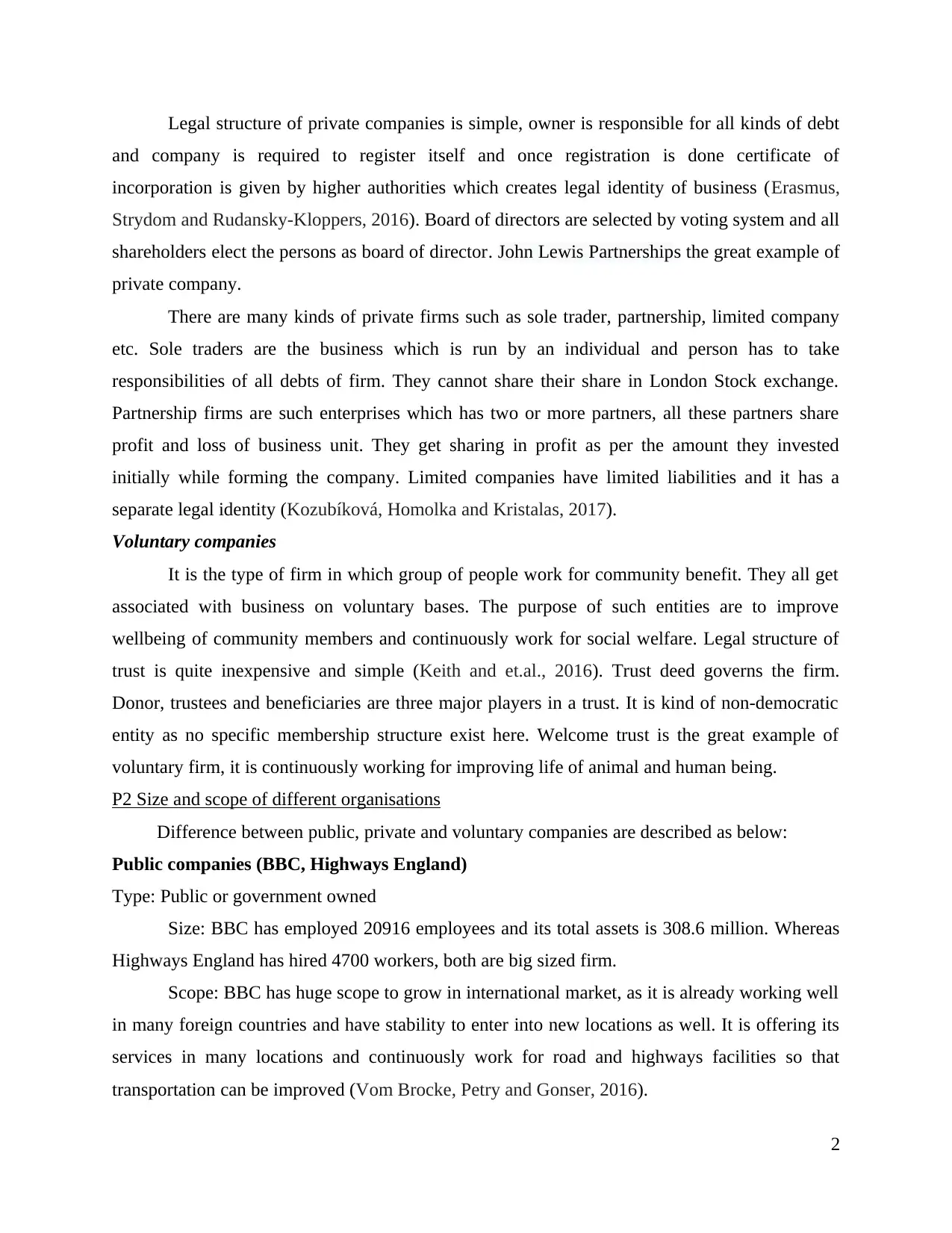
Legal structure of private companies is simple, owner is responsible for all kinds of debt
and company is required to register itself and once registration is done certificate of
incorporation is given by higher authorities which creates legal identity of business (Erasmus,
Strydom and Rudansky-Kloppers, 2016). Board of directors are selected by voting system and all
shareholders elect the persons as board of director. John Lewis Partnerships the great example of
private company.
There are many kinds of private firms such as sole trader, partnership, limited company
etc. Sole traders are the business which is run by an individual and person has to take
responsibilities of all debts of firm. They cannot share their share in London Stock exchange.
Partnership firms are such enterprises which has two or more partners, all these partners share
profit and loss of business unit. They get sharing in profit as per the amount they invested
initially while forming the company. Limited companies have limited liabilities and it has a
separate legal identity (Kozubíková, Homolka and Kristalas, 2017).
Voluntary companies
It is the type of firm in which group of people work for community benefit. They all get
associated with business on voluntary bases. The purpose of such entities are to improve
wellbeing of community members and continuously work for social welfare. Legal structure of
trust is quite inexpensive and simple (Keith and et.al., 2016). Trust deed governs the firm.
Donor, trustees and beneficiaries are three major players in a trust. It is kind of non-democratic
entity as no specific membership structure exist here. Welcome trust is the great example of
voluntary firm, it is continuously working for improving life of animal and human being.
P2 Size and scope of different organisations
Difference between public, private and voluntary companies are described as below:
Public companies (BBC, Highways England)
Type: Public or government owned
Size: BBC has employed 20916 employees and its total assets is 308.6 million. Whereas
Highways England has hired 4700 workers, both are big sized firm.
Scope: BBC has huge scope to grow in international market, as it is already working well
in many foreign countries and have stability to enter into new locations as well. It is offering its
services in many locations and continuously work for road and highways facilities so that
transportation can be improved (Vom Brocke, Petry and Gonser, 2016).
2
and company is required to register itself and once registration is done certificate of
incorporation is given by higher authorities which creates legal identity of business (Erasmus,
Strydom and Rudansky-Kloppers, 2016). Board of directors are selected by voting system and all
shareholders elect the persons as board of director. John Lewis Partnerships the great example of
private company.
There are many kinds of private firms such as sole trader, partnership, limited company
etc. Sole traders are the business which is run by an individual and person has to take
responsibilities of all debts of firm. They cannot share their share in London Stock exchange.
Partnership firms are such enterprises which has two or more partners, all these partners share
profit and loss of business unit. They get sharing in profit as per the amount they invested
initially while forming the company. Limited companies have limited liabilities and it has a
separate legal identity (Kozubíková, Homolka and Kristalas, 2017).
Voluntary companies
It is the type of firm in which group of people work for community benefit. They all get
associated with business on voluntary bases. The purpose of such entities are to improve
wellbeing of community members and continuously work for social welfare. Legal structure of
trust is quite inexpensive and simple (Keith and et.al., 2016). Trust deed governs the firm.
Donor, trustees and beneficiaries are three major players in a trust. It is kind of non-democratic
entity as no specific membership structure exist here. Welcome trust is the great example of
voluntary firm, it is continuously working for improving life of animal and human being.
P2 Size and scope of different organisations
Difference between public, private and voluntary companies are described as below:
Public companies (BBC, Highways England)
Type: Public or government owned
Size: BBC has employed 20916 employees and its total assets is 308.6 million. Whereas
Highways England has hired 4700 workers, both are big sized firm.
Scope: BBC has huge scope to grow in international market, as it is already working well
in many foreign countries and have stability to enter into new locations as well. It is offering its
services in many locations and continuously work for road and highways facilities so that
transportation can be improved (Vom Brocke, Petry and Gonser, 2016).
2
Paraphrase This Document
Need a fresh take? Get an instant paraphrase of this document with our AI Paraphraser
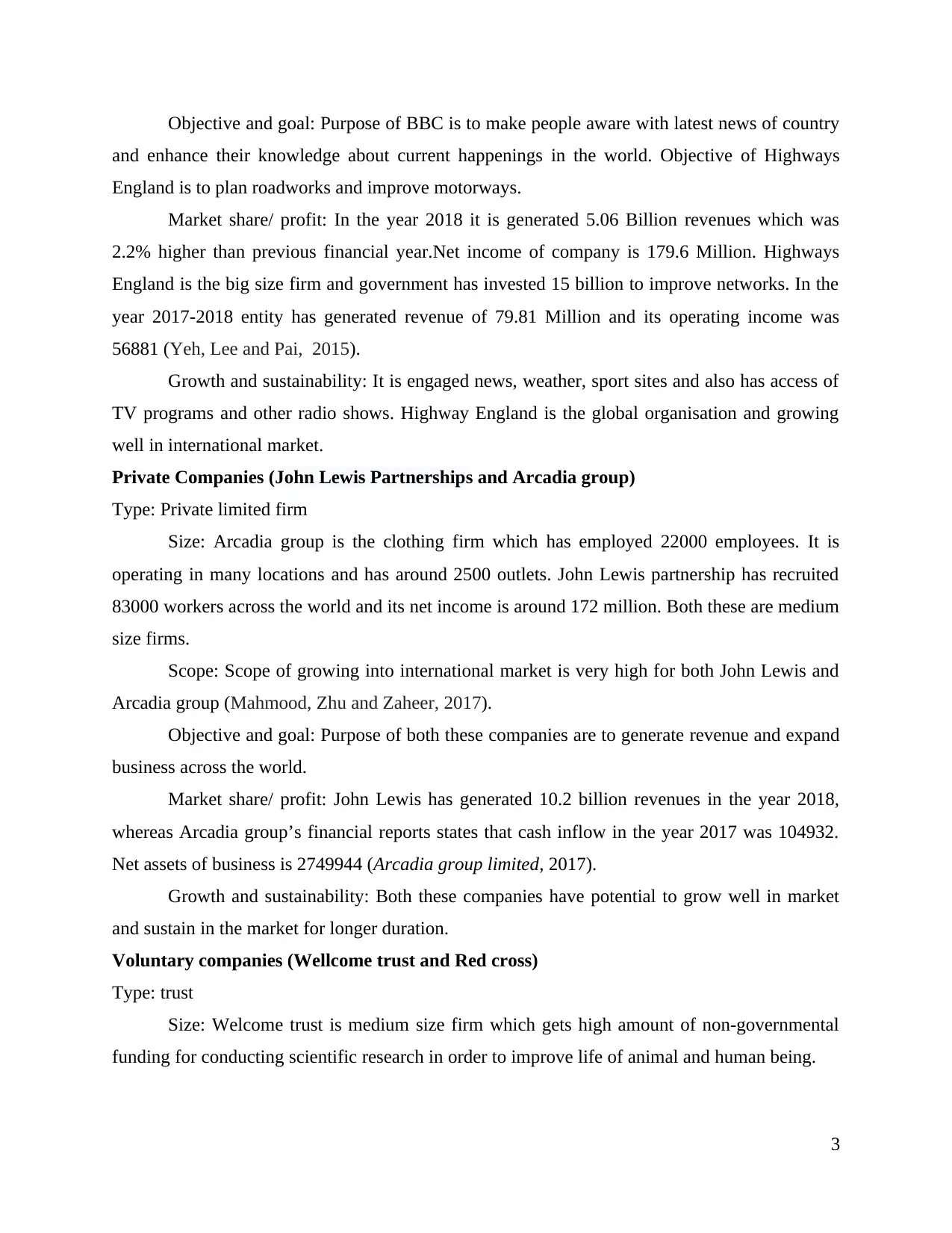
Objective and goal: Purpose of BBC is to make people aware with latest news of country
and enhance their knowledge about current happenings in the world. Objective of Highways
England is to plan roadworks and improve motorways.
Market share/ profit: In the year 2018 it is generated 5.06 Billion revenues which was
2.2% higher than previous financial year.Net income of company is 179.6 Million. Highways
England is the big size firm and government has invested 15 billion to improve networks. In the
year 2017-2018 entity has generated revenue of 79.81 Million and its operating income was
56881 (Yeh, Lee and Pai, 2015).
Growth and sustainability: It is engaged news, weather, sport sites and also has access of
TV programs and other radio shows. Highway England is the global organisation and growing
well in international market.
Private Companies (John Lewis Partnerships and Arcadia group)
Type: Private limited firm
Size: Arcadia group is the clothing firm which has employed 22000 employees. It is
operating in many locations and has around 2500 outlets. John Lewis partnership has recruited
83000 workers across the world and its net income is around 172 million. Both these are medium
size firms.
Scope: Scope of growing into international market is very high for both John Lewis and
Arcadia group (Mahmood, Zhu and Zaheer, 2017).
Objective and goal: Purpose of both these companies are to generate revenue and expand
business across the world.
Market share/ profit: John Lewis has generated 10.2 billion revenues in the year 2018,
whereas Arcadia group’s financial reports states that cash inflow in the year 2017 was 104932.
Net assets of business is 2749944 (Arcadia group limited, 2017).
Growth and sustainability: Both these companies have potential to grow well in market
and sustain in the market for longer duration.
Voluntary companies (Wellcome trust and Red cross)
Type: trust
Size: Welcome trust is medium size firm which gets high amount of non-governmental
funding for conducting scientific research in order to improve life of animal and human being.
3
and enhance their knowledge about current happenings in the world. Objective of Highways
England is to plan roadworks and improve motorways.
Market share/ profit: In the year 2018 it is generated 5.06 Billion revenues which was
2.2% higher than previous financial year.Net income of company is 179.6 Million. Highways
England is the big size firm and government has invested 15 billion to improve networks. In the
year 2017-2018 entity has generated revenue of 79.81 Million and its operating income was
56881 (Yeh, Lee and Pai, 2015).
Growth and sustainability: It is engaged news, weather, sport sites and also has access of
TV programs and other radio shows. Highway England is the global organisation and growing
well in international market.
Private Companies (John Lewis Partnerships and Arcadia group)
Type: Private limited firm
Size: Arcadia group is the clothing firm which has employed 22000 employees. It is
operating in many locations and has around 2500 outlets. John Lewis partnership has recruited
83000 workers across the world and its net income is around 172 million. Both these are medium
size firms.
Scope: Scope of growing into international market is very high for both John Lewis and
Arcadia group (Mahmood, Zhu and Zaheer, 2017).
Objective and goal: Purpose of both these companies are to generate revenue and expand
business across the world.
Market share/ profit: John Lewis has generated 10.2 billion revenues in the year 2018,
whereas Arcadia group’s financial reports states that cash inflow in the year 2017 was 104932.
Net assets of business is 2749944 (Arcadia group limited, 2017).
Growth and sustainability: Both these companies have potential to grow well in market
and sustain in the market for longer duration.
Voluntary companies (Wellcome trust and Red cross)
Type: trust
Size: Welcome trust is medium size firm which gets high amount of non-governmental
funding for conducting scientific research in order to improve life of animal and human being.
3
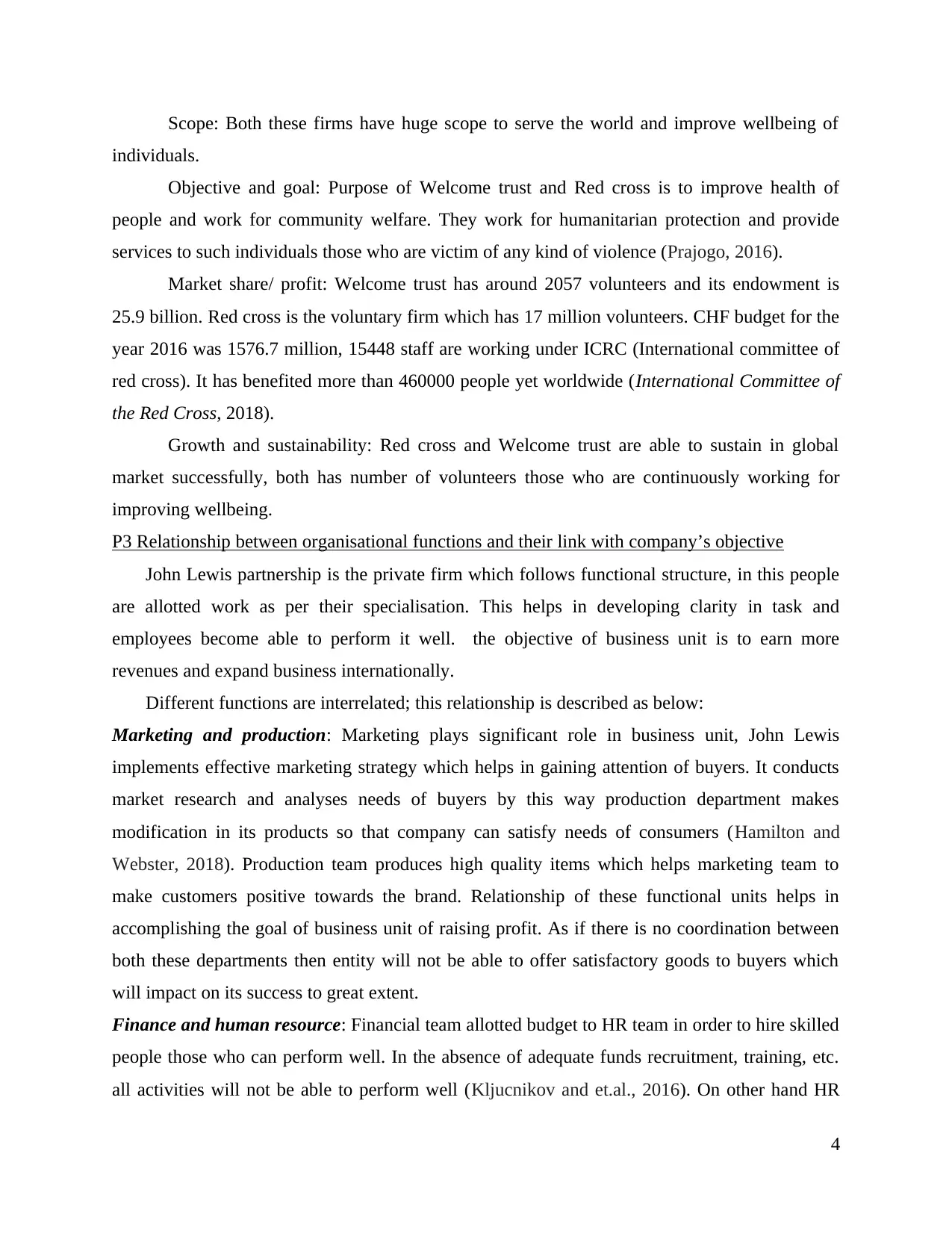
Scope: Both these firms have huge scope to serve the world and improve wellbeing of
individuals.
Objective and goal: Purpose of Welcome trust and Red cross is to improve health of
people and work for community welfare. They work for humanitarian protection and provide
services to such individuals those who are victim of any kind of violence (Prajogo, 2016).
Market share/ profit: Welcome trust has around 2057 volunteers and its endowment is
25.9 billion. Red cross is the voluntary firm which has 17 million volunteers. CHF budget for the
year 2016 was 1576.7 million, 15448 staff are working under ICRC (International committee of
red cross). It has benefited more than 460000 people yet worldwide (International Committee of
the Red Cross, 2018).
Growth and sustainability: Red cross and Welcome trust are able to sustain in global
market successfully, both has number of volunteers those who are continuously working for
improving wellbeing.
P3 Relationship between organisational functions and their link with company’s objective
John Lewis partnership is the private firm which follows functional structure, in this people
are allotted work as per their specialisation. This helps in developing clarity in task and
employees become able to perform it well. the objective of business unit is to earn more
revenues and expand business internationally.
Different functions are interrelated; this relationship is described as below:
Marketing and production: Marketing plays significant role in business unit, John Lewis
implements effective marketing strategy which helps in gaining attention of buyers. It conducts
market research and analyses needs of buyers by this way production department makes
modification in its products so that company can satisfy needs of consumers (Hamilton and
Webster, 2018). Production team produces high quality items which helps marketing team to
make customers positive towards the brand. Relationship of these functional units helps in
accomplishing the goal of business unit of raising profit. As if there is no coordination between
both these departments then entity will not be able to offer satisfactory goods to buyers which
will impact on its success to great extent.
Finance and human resource: Financial team allotted budget to HR team in order to hire skilled
people those who can perform well. In the absence of adequate funds recruitment, training, etc.
all activities will not be able to perform well (Kljucnikov and et.al., 2016). On other hand HR
4
individuals.
Objective and goal: Purpose of Welcome trust and Red cross is to improve health of
people and work for community welfare. They work for humanitarian protection and provide
services to such individuals those who are victim of any kind of violence (Prajogo, 2016).
Market share/ profit: Welcome trust has around 2057 volunteers and its endowment is
25.9 billion. Red cross is the voluntary firm which has 17 million volunteers. CHF budget for the
year 2016 was 1576.7 million, 15448 staff are working under ICRC (International committee of
red cross). It has benefited more than 460000 people yet worldwide (International Committee of
the Red Cross, 2018).
Growth and sustainability: Red cross and Welcome trust are able to sustain in global
market successfully, both has number of volunteers those who are continuously working for
improving wellbeing.
P3 Relationship between organisational functions and their link with company’s objective
John Lewis partnership is the private firm which follows functional structure, in this people
are allotted work as per their specialisation. This helps in developing clarity in task and
employees become able to perform it well. the objective of business unit is to earn more
revenues and expand business internationally.
Different functions are interrelated; this relationship is described as below:
Marketing and production: Marketing plays significant role in business unit, John Lewis
implements effective marketing strategy which helps in gaining attention of buyers. It conducts
market research and analyses needs of buyers by this way production department makes
modification in its products so that company can satisfy needs of consumers (Hamilton and
Webster, 2018). Production team produces high quality items which helps marketing team to
make customers positive towards the brand. Relationship of these functional units helps in
accomplishing the goal of business unit of raising profit. As if there is no coordination between
both these departments then entity will not be able to offer satisfactory goods to buyers which
will impact on its success to great extent.
Finance and human resource: Financial team allotted budget to HR team in order to hire skilled
people those who can perform well. In the absence of adequate funds recruitment, training, etc.
all activities will not be able to perform well (Kljucnikov and et.al., 2016). On other hand HR
4
⊘ This is a preview!⊘
Do you want full access?
Subscribe today to unlock all pages.

Trusted by 1+ million students worldwide
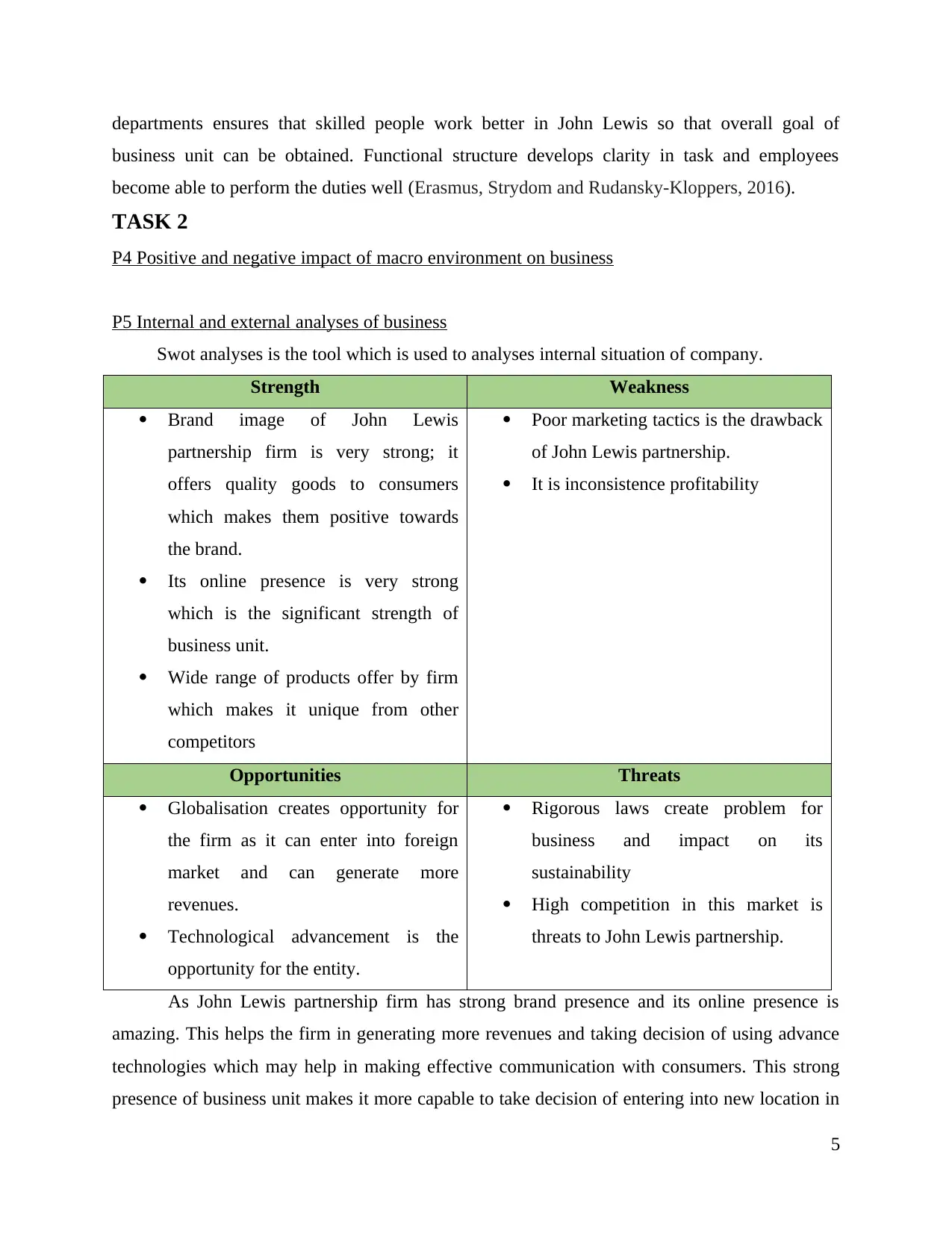
departments ensures that skilled people work better in John Lewis so that overall goal of
business unit can be obtained. Functional structure develops clarity in task and employees
become able to perform the duties well (Erasmus, Strydom and Rudansky-Kloppers, 2016).
TASK 2
P4 Positive and negative impact of macro environment on business
P5 Internal and external analyses of business
Swot analyses is the tool which is used to analyses internal situation of company.
Strength Weakness
Brand image of John Lewis
partnership firm is very strong; it
offers quality goods to consumers
which makes them positive towards
the brand.
Its online presence is very strong
which is the significant strength of
business unit.
Wide range of products offer by firm
which makes it unique from other
competitors
Poor marketing tactics is the drawback
of John Lewis partnership.
It is inconsistence profitability
Opportunities Threats
Globalisation creates opportunity for
the firm as it can enter into foreign
market and can generate more
revenues.
Technological advancement is the
opportunity for the entity.
Rigorous laws create problem for
business and impact on its
sustainability
High competition in this market is
threats to John Lewis partnership.
As John Lewis partnership firm has strong brand presence and its online presence is
amazing. This helps the firm in generating more revenues and taking decision of using advance
technologies which may help in making effective communication with consumers. This strong
presence of business unit makes it more capable to take decision of entering into new location in
5
business unit can be obtained. Functional structure develops clarity in task and employees
become able to perform the duties well (Erasmus, Strydom and Rudansky-Kloppers, 2016).
TASK 2
P4 Positive and negative impact of macro environment on business
P5 Internal and external analyses of business
Swot analyses is the tool which is used to analyses internal situation of company.
Strength Weakness
Brand image of John Lewis
partnership firm is very strong; it
offers quality goods to consumers
which makes them positive towards
the brand.
Its online presence is very strong
which is the significant strength of
business unit.
Wide range of products offer by firm
which makes it unique from other
competitors
Poor marketing tactics is the drawback
of John Lewis partnership.
It is inconsistence profitability
Opportunities Threats
Globalisation creates opportunity for
the firm as it can enter into foreign
market and can generate more
revenues.
Technological advancement is the
opportunity for the entity.
Rigorous laws create problem for
business and impact on its
sustainability
High competition in this market is
threats to John Lewis partnership.
As John Lewis partnership firm has strong brand presence and its online presence is
amazing. This helps the firm in generating more revenues and taking decision of using advance
technologies which may help in making effective communication with consumers. This strong
presence of business unit makes it more capable to take decision of entering into new location in
5
Paraphrase This Document
Need a fresh take? Get an instant paraphrase of this document with our AI Paraphraser
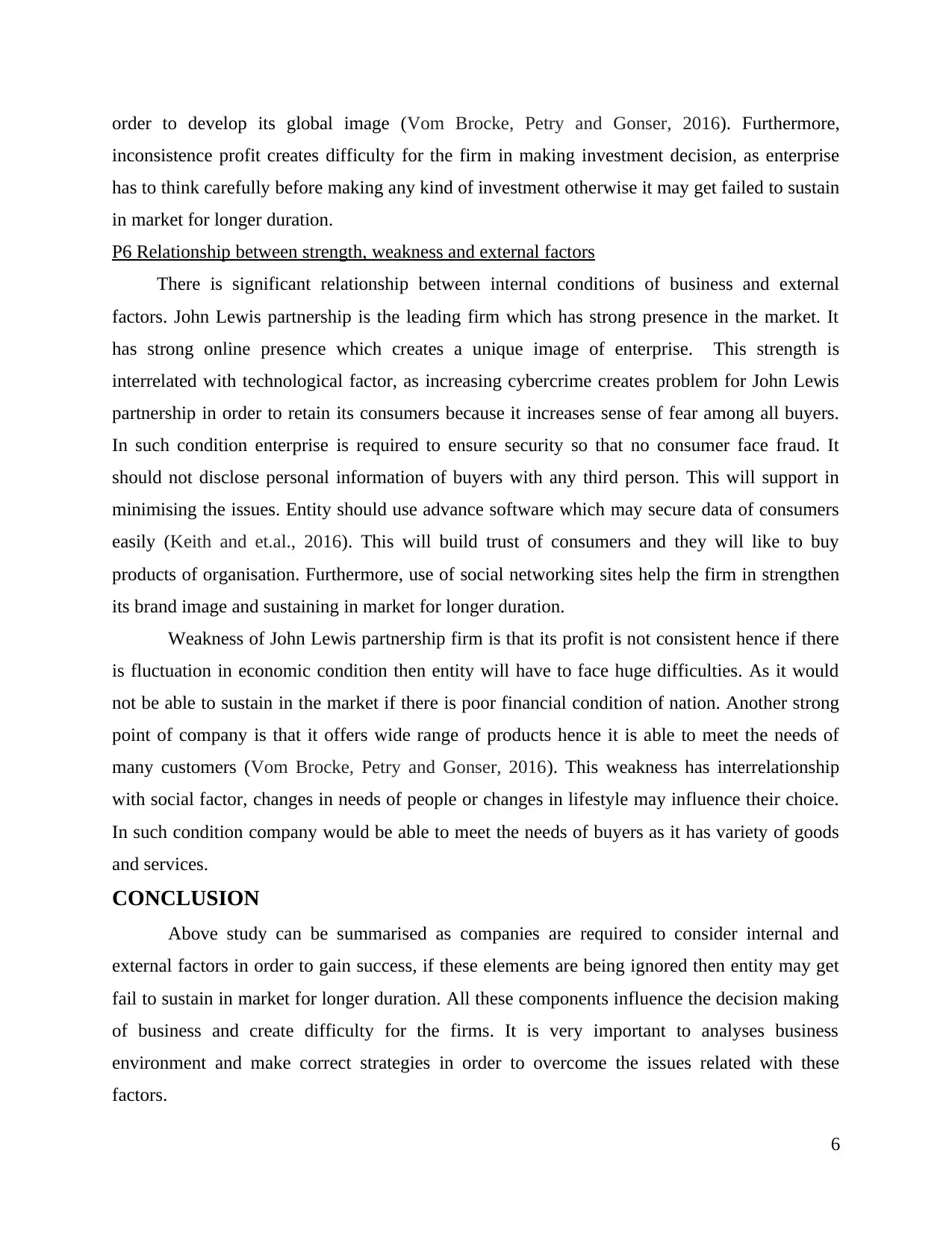
order to develop its global image (Vom Brocke, Petry and Gonser, 2016). Furthermore,
inconsistence profit creates difficulty for the firm in making investment decision, as enterprise
has to think carefully before making any kind of investment otherwise it may get failed to sustain
in market for longer duration.
P6 Relationship between strength, weakness and external factors
There is significant relationship between internal conditions of business and external
factors. John Lewis partnership is the leading firm which has strong presence in the market. It
has strong online presence which creates a unique image of enterprise. This strength is
interrelated with technological factor, as increasing cybercrime creates problem for John Lewis
partnership in order to retain its consumers because it increases sense of fear among all buyers.
In such condition enterprise is required to ensure security so that no consumer face fraud. It
should not disclose personal information of buyers with any third person. This will support in
minimising the issues. Entity should use advance software which may secure data of consumers
easily (Keith and et.al., 2016). This will build trust of consumers and they will like to buy
products of organisation. Furthermore, use of social networking sites help the firm in strengthen
its brand image and sustaining in market for longer duration.
Weakness of John Lewis partnership firm is that its profit is not consistent hence if there
is fluctuation in economic condition then entity will have to face huge difficulties. As it would
not be able to sustain in the market if there is poor financial condition of nation. Another strong
point of company is that it offers wide range of products hence it is able to meet the needs of
many customers (Vom Brocke, Petry and Gonser, 2016). This weakness has interrelationship
with social factor, changes in needs of people or changes in lifestyle may influence their choice.
In such condition company would be able to meet the needs of buyers as it has variety of goods
and services.
CONCLUSION
Above study can be summarised as companies are required to consider internal and
external factors in order to gain success, if these elements are being ignored then entity may get
fail to sustain in market for longer duration. All these components influence the decision making
of business and create difficulty for the firms. It is very important to analyses business
environment and make correct strategies in order to overcome the issues related with these
factors.
6
inconsistence profit creates difficulty for the firm in making investment decision, as enterprise
has to think carefully before making any kind of investment otherwise it may get failed to sustain
in market for longer duration.
P6 Relationship between strength, weakness and external factors
There is significant relationship between internal conditions of business and external
factors. John Lewis partnership is the leading firm which has strong presence in the market. It
has strong online presence which creates a unique image of enterprise. This strength is
interrelated with technological factor, as increasing cybercrime creates problem for John Lewis
partnership in order to retain its consumers because it increases sense of fear among all buyers.
In such condition enterprise is required to ensure security so that no consumer face fraud. It
should not disclose personal information of buyers with any third person. This will support in
minimising the issues. Entity should use advance software which may secure data of consumers
easily (Keith and et.al., 2016). This will build trust of consumers and they will like to buy
products of organisation. Furthermore, use of social networking sites help the firm in strengthen
its brand image and sustaining in market for longer duration.
Weakness of John Lewis partnership firm is that its profit is not consistent hence if there
is fluctuation in economic condition then entity will have to face huge difficulties. As it would
not be able to sustain in the market if there is poor financial condition of nation. Another strong
point of company is that it offers wide range of products hence it is able to meet the needs of
many customers (Vom Brocke, Petry and Gonser, 2016). This weakness has interrelationship
with social factor, changes in needs of people or changes in lifestyle may influence their choice.
In such condition company would be able to meet the needs of buyers as it has variety of goods
and services.
CONCLUSION
Above study can be summarised as companies are required to consider internal and
external factors in order to gain success, if these elements are being ignored then entity may get
fail to sustain in market for longer duration. All these components influence the decision making
of business and create difficulty for the firms. It is very important to analyses business
environment and make correct strategies in order to overcome the issues related with these
factors.
6
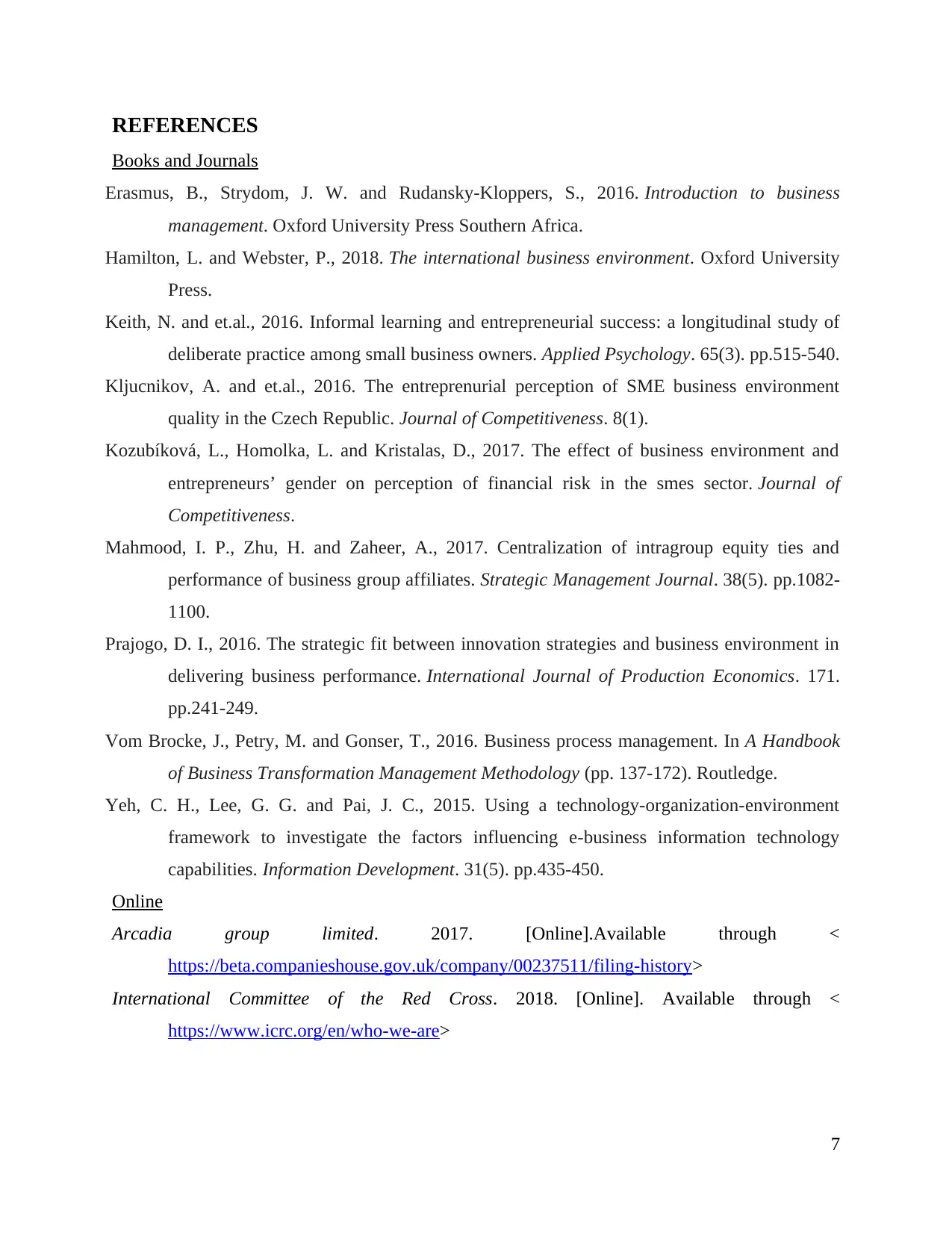
REFERENCES
Books and Journals
Erasmus, B., Strydom, J. W. and Rudansky-Kloppers, S., 2016. Introduction to business
management. Oxford University Press Southern Africa.
Hamilton, L. and Webster, P., 2018. The international business environment. Oxford University
Press.
Keith, N. and et.al., 2016. Informal learning and entrepreneurial success: a longitudinal study of
deliberate practice among small business owners. Applied Psychology. 65(3). pp.515-540.
Kljucnikov, A. and et.al., 2016. The entreprenurial perception of SME business environment
quality in the Czech Republic. Journal of Competitiveness. 8(1).
Kozubíková, L., Homolka, L. and Kristalas, D., 2017. The effect of business environment and
entrepreneurs’ gender on perception of financial risk in the smes sector. Journal of
Competitiveness.
Mahmood, I. P., Zhu, H. and Zaheer, A., 2017. Centralization of intragroup equity ties and
performance of business group affiliates. Strategic Management Journal. 38(5). pp.1082-
1100.
Prajogo, D. I., 2016. The strategic fit between innovation strategies and business environment in
delivering business performance. International Journal of Production Economics. 171.
pp.241-249.
Vom Brocke, J., Petry, M. and Gonser, T., 2016. Business process management. In A Handbook
of Business Transformation Management Methodology (pp. 137-172). Routledge.
Yeh, C. H., Lee, G. G. and Pai, J. C., 2015. Using a technology-organization-environment
framework to investigate the factors influencing e-business information technology
capabilities. Information Development. 31(5). pp.435-450.
Online
Arcadia group limited. 2017. [Online].Available through <
https://beta.companieshouse.gov.uk/company/00237511/filing-history>
International Committee of the Red Cross. 2018. [Online]. Available through <
https://www.icrc.org/en/who-we-are>
7
Books and Journals
Erasmus, B., Strydom, J. W. and Rudansky-Kloppers, S., 2016. Introduction to business
management. Oxford University Press Southern Africa.
Hamilton, L. and Webster, P., 2018. The international business environment. Oxford University
Press.
Keith, N. and et.al., 2016. Informal learning and entrepreneurial success: a longitudinal study of
deliberate practice among small business owners. Applied Psychology. 65(3). pp.515-540.
Kljucnikov, A. and et.al., 2016. The entreprenurial perception of SME business environment
quality in the Czech Republic. Journal of Competitiveness. 8(1).
Kozubíková, L., Homolka, L. and Kristalas, D., 2017. The effect of business environment and
entrepreneurs’ gender on perception of financial risk in the smes sector. Journal of
Competitiveness.
Mahmood, I. P., Zhu, H. and Zaheer, A., 2017. Centralization of intragroup equity ties and
performance of business group affiliates. Strategic Management Journal. 38(5). pp.1082-
1100.
Prajogo, D. I., 2016. The strategic fit between innovation strategies and business environment in
delivering business performance. International Journal of Production Economics. 171.
pp.241-249.
Vom Brocke, J., Petry, M. and Gonser, T., 2016. Business process management. In A Handbook
of Business Transformation Management Methodology (pp. 137-172). Routledge.
Yeh, C. H., Lee, G. G. and Pai, J. C., 2015. Using a technology-organization-environment
framework to investigate the factors influencing e-business information technology
capabilities. Information Development. 31(5). pp.435-450.
Online
Arcadia group limited. 2017. [Online].Available through <
https://beta.companieshouse.gov.uk/company/00237511/filing-history>
International Committee of the Red Cross. 2018. [Online]. Available through <
https://www.icrc.org/en/who-we-are>
7
⊘ This is a preview!⊘
Do you want full access?
Subscribe today to unlock all pages.

Trusted by 1+ million students worldwide

8
1 out of 10
Related Documents
Your All-in-One AI-Powered Toolkit for Academic Success.
+13062052269
info@desklib.com
Available 24*7 on WhatsApp / Email
![[object Object]](/_next/static/media/star-bottom.7253800d.svg)
Unlock your academic potential
Copyright © 2020–2025 A2Z Services. All Rights Reserved. Developed and managed by ZUCOL.





